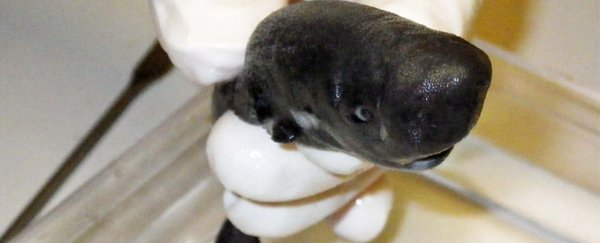We all know sharks have had a bit of an undeserved bad rap (thanks Jaws!). But if you're one of those people who find sharks scary, this newly identified species of pocket shark might just change your mind.
First up, it's only about 14 centimetres (5.5 inches) long and has its own pockets tucked in behind its pectoral fins, with glands inside that produce a bioluminescent fluid.
It also has light-producing organs called photophores all over its body – so yep, this tiny shark glows in the dark.
This pocket shark (Mollisquama mississippiensis) was discovered in the central Gulf of Mexico in February 2010. It has just been classified as a new species and is one of only two pocket sharks ever found.
"In the history of fisheries science, only two pocket sharks have ever been captured or reported," said Mark Grace, a biologist at the National Oceanic and Atmospheric Administration (NOAA).
"Both are separate species, each from separate oceans. Both are exceedingly rare."
The first pocket shark (Mollisquama parini) ever discovered was found off the coast of Chile in the Nazca Submarine Range in 1979 and described in 1984.
That shark was an adult female, around 40 centimeters (16 inches) long.
And then nothing. No more species were found until this newly described young male was found in 2010. So what was going on?
Unfortunately, we still don't know. The ocean is a big place, and we have only explored a small amount of it.
Pocket sharks also live well below the surface of the water - the original pocket shark was found at 330 meters (1,083-feet) deep.
"The fact that only one pocket shark has ever been reported from the Gulf of Mexico, and that it is a new species, underscores how little we know about the Gulf - especially its deeper waters - and how many additional new species from these waters await discovery," explained Henry Bart, director of the Tulane Biodiversity Research Institute.
The researchers used x-ray images and high resolution CT scans to get a look at both the outside and inside of the shark and see how the two species differed.

Both species have the cute little pockets that produce bioluminous fluid (these sit near the gills) and have similar features.
However, the M. mississippiensis pocket shark has fewer vertebrae, and has photophores, while the original pocket shark doesn't.
But until we know more about these little guys, just enjoy the thought there are tiny, pocket-sized sharks, with their own little pockets, that glow in the dark.
Take that, Jaws.
The research has been published in Zootaxa.
